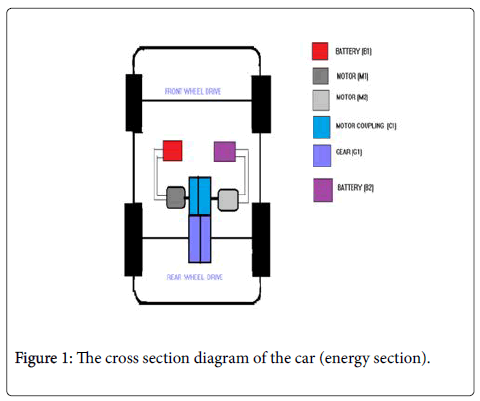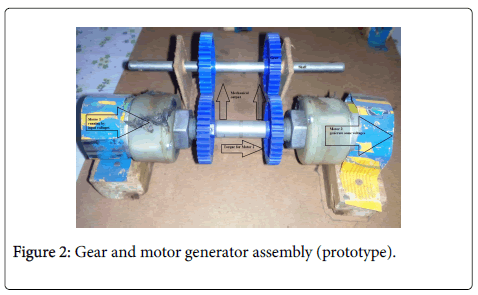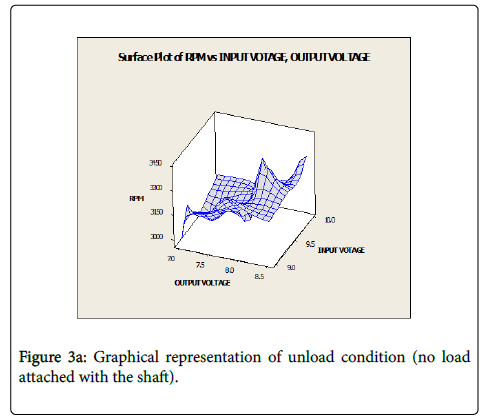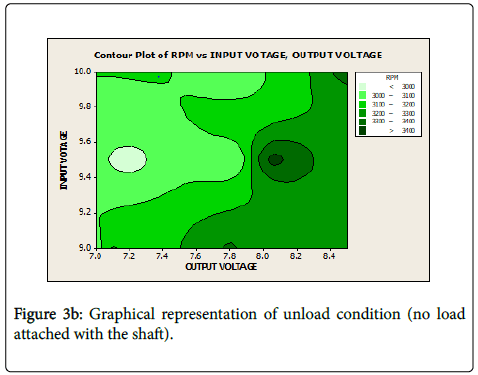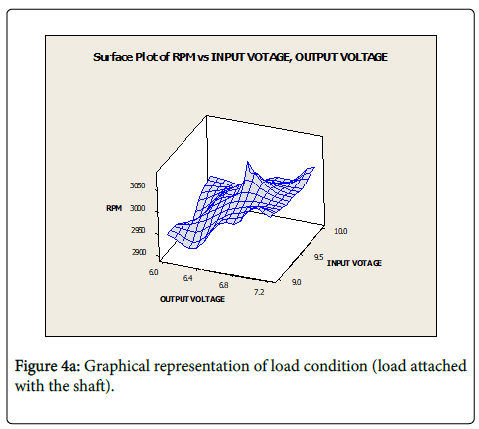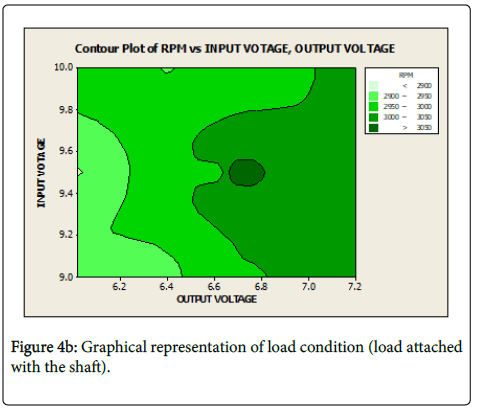Power Generating Low Cost Green Electric Vehicle
Received: 23-Aug-2018 / Accepted Date: 15-Sep-2018 / Published Date: 22-Sep-2018 DOI: 10.4172/2576-1463.1000217
Keywords: Electric car; Hybrid electric car; ICE; Electric motor
Introduction
“ALL OF THOSE CARS WERE ONCE JUST A DREAM IN SOMEBODY’S HEAD”
- PETER GABRIEL.
The first automobile was invented in Germany later it was developed and modified in Germany and France in the late 1800.Later in the first half of twentieth century’s Americans came to rule the automotive industry. Henry Ford invented the mass production techniques and that was quickly adopted. Ford, General Motors and Chrysler evolved as the “Big Three” auto companies by the 1920s [1]. In 1769 French Engineer Nicolas joseph Cugnot invented the first selfpropelled vehicle was a military tractor [2]. He used steam engine to power up his vehicle. The steam engine and boiler is placed in front side of the vehicle that separates boiler and steam engine from rest of vehicle. Steam engine is called external combustion engine as the combustion takes place outside of the engine [3]. In steam engine, the combustion causes heat generation to generate high pressure steam which is used as a working fluid of the engine [4].
A steam engine powered car was used by French army for artillery purposes. It attained a speed of 2 and 1/2 mph. The main disadvantage of the steam powered cars is that the vehicle stops every ten to fifteen minutes to release steam that is used to power up the engine which leads to heavy weight to the vehicles. Due to that reason it was only used in locomotives. After the invention of steam engine powered automobile then came dawn of electric automobiles. Sometime between 1832 and 1839, Robert Anderson of Scotland invented the first electric carriage [5]. EV (electric vehicle) was very popular and was sold during 1918. But they were relied on rechargeable batteries having a small capacity. To overcome the above issues mass production of the ICE powered cars prevailed in the market [6]. In the middle of the 19th century, the vehicles were powered by steam engine [7].
By the 1933 all electric cars was replaced by gasoline and ICE vehicles. The invention of steam engine was crucial for the industrial revolution [8]. People were looking for internal combustion engine for very long period of time but the proper source of purified fuel was not available at that time [9]. Some early experiments were utilized fuels like hydrogen and coal gas but it was unsuccessful experiment [10]. Petroleum arrived on the scene and became widely available in the 1950s that the internal combustion engine was really able to take off [11]. German inventor named Nikolaus Otto developed his own internal combustion engine. Ottos engine utilized the same four stroke engine that had been designed and patented by French engineer Alphonse Beau de Rochas but Otto’s design was more practical and he proposed a constant volume heat addition which forms the basics of today’s SI (Spark Ignition) engine [12]. He developed two engines (the Otto silent engine and the Otto-Langen engine), and modern fourstroke engines continue to utilize the Otto cycle [13].
Later in the 19th century British Engineer developed components like the jet spray carburetor, spark plug, ignition coil, and magneto in 1884 [14]. ICE powered cars replaced electric cars due to mass production, inefficient and mainly due to low speed [15]. Thomas Edison and Henry Ford tried to make electric cars as efficient as the ICE engine. Thomas Edison and Henry ford work together on affordable electric cars [16]. The ford company was found in 1903 [17]. At that time Edison used to build nickel-iron batteries for several uses, including automobiles. Later that year he decided to turn all cars to affordable electric cars. That time Ford Company produced gasoline powered cars. Ford was very much busy with production of gasoline powered vehicle. Ford began to change his mind, however, and by early 1914, word spread that he was working on a low-priced electric car. Reports appeared in the Wall Street Journal, in trade magazines and in newspapers as far away as New Zealand regarding Ford's foray into EV (Electric vehicle). The car was built on 1913 [18].
The EV was tiller-steered with an unusually swoopy frame and batteries under the seat. The man operating it, Fred Allison, was an electrical engineer from Detroit. The EV (Electrical vehicle) has a maximum speed of 25 mph. They used Model T frame, suspension, front axle and model T steering wheel and worm rear axle. The latter indicates the motor, mounted behind the driver in the first prototype, was up front in the second, near an additional bank of batteries. The theorists offer as evidence the "mysterious" fire that nearly destroyed Edison's workshops in West Orange, New Jersey, in December; 1914. This was the downfall of Edison-Ford electric car. Edison used nickeliron batteries in the car but the batteries were however, were found to have very high internal resistance and were thus incapable of powering an electric car under many circumstances. Thus ICE powered vehicle prevailed at that time.
ICE (Internal Combustion Engine) Powered Vehicle
Internal combustion engine is group of mechanical devices in which reactants of combustion and products of combustion serve as the working fluid of the engine. Such an engine gains its energy from heat released during the combustion of the non-reacted working fluids, the oxidizer-fuel mixture. The process occurring in ICE is thermodynamic process [19]. Useful work generated by an ICE results from the hot gaseous products of combustion acting on moving surfaces of the engine, such as the face of a piston, a turbine blade, or a nozzle [20].
The engine does this through either internal or external combustion. Combustion is the act of burning. Internal means closed or inside. Thus, in internal combustion engines, burning of fuel takes place inside of an engine; that is, burning takes place within the same cylinder to provide a power stroke to turn the crankshaft of the engine. Within internal combustion engine the combustion takes place inside the cylinder and is directly responsible for forcing the piston to move downward. The change of heat energy to mechanical energy by the engine is based on thermodynamics law. It states that gas will expand upon the application of heat. The law also states that the compression of gas will increase its temperature. If the gas is confined with no outlet for expansion, the application of heat will increase the pressure of the gas. In an engine this pressure acts against the head of the piston causing to move downward [21].
For ICE 4 stroke engine, for one cycle of process there is only one power stroke is obtained from the engine .The fluid needs to be combusted to obtain the mechanical output of the engine [22]. In each of these strokes the pressure is altered and thus finally a sufficiently high pressure and the combusted products are released out of the exhaust manifold during the stroke exhaust. The products of the combusted products are released into the surrounding. Some of the fuel (hydrocarbon) may not completely burn during combustion and therefore is released into the atmosphere along with the products. Exhaust gas of combustion of diesel fuel are carbon dioxide, water vapor, nitrogen, Carbon monoxide, oxides of sulphur [23,24].
CO2 and global warming
CO2 Emissions cause global warming. CO2 gas traps heat and cause global warming. The climate change and increase in the average temperature of the earth mainly due to the CO2 emissions and the concentration of CO2 in the atmosphere is increasing day by day [25].
Ozone layer depletion
NO2 is one of the reasons for the ozone layer depletion. NO2 in the atmosphere reacts with ozone to form nitric oxide as it takes away the single atom from ozone molecule to form nitric oxide. The nitric oxide stays in the atmosphere until it is washed by rain to form acid rain [26].
ICE vehicles and pollution
Hydrocarbons are the emissions of the automobile and they contribute to asthma, liver disease and cancer overexposure of carbon monoxide may be fatal. NO2 causes ozone layer depletion and Nitric oxide formed in the atmosphere is being washed as acid rain and it destroys the resistance to respiratory infection. Toxins from the automobile kill fish, plants, aquatic life and even people. It also depletes water of oxygen, killing fish and aquatic life [27].
EV (Electric Vehicle)
After failure of Thomas Edison and Henry Ford, the American entrepreneurs Martin Eberhard and Marc Tarpenning founded electric car manufacturing company named as Tesla Motors after the name of Serbian American inventor Nikola Tesla. The funding of Tesla Motors received from Elon Musk who is founder of SpaceX and co -founder of PayPal funded them and he became chairman of Tesla in 2004. Tesla released its first car named as Tesla Road star in 2008. It achieved 245 miles on a single charge [28]. Tesla cars use induction motors and lithium ion batteries to power up the vehicle. Tesla becomes very successful. Lithium ion batteries have unmatchable combination of high energy and power electronics, and also used to power EV.
Hybrid car
The concept of Hybrid electric car came up in the year of 1990. It consists of ICE along with electric motor. The power supply of hybrid car comes from onboard batteries and ICE. In HEV-IC engine cooperates with an electric motor for optimum use of engine so the HEV (Hybrid Electric Vehicle) is better efficient than the ICE powered vehicle. HEV is not completely eco-friendly as it creates pollution and exhausts harmful gases.
Electric vehicle data
Data for normal electric vehicle is mentioned in the below table (Table 1).
| Voltage (input) (in V) | Ampere (input) (in mA) | R.P.M |
|---|---|---|
| 10.05 | 9.6 | 3519.7 |
| 10.02 | 9.1 | 3470.8 |
| 10 | 9 | 3300.9 |
| 9.6 | 8.5 | 3221.1 |
| 9.9 | 8.5 | 3244.8 |
| 10.04 | 9.2 | 3498.3 |
| 10.2 | 9 | 3380.9 |
| 10.1 | 9.01 | 3300.2 |
| 9.9 | 8.7 | 3245.9 |
| 9.8 | 8.8 | 3200.5 |
| 10.5 | 9.6 | 3412.7 |
| 9.7 | 8.08 | 3245.8 |
| 9.5 | 8.4 | 3210.4 |
| 10.6 | 9.7 | 3421.5 |
| 10.6 | 9.7 | 3425.6 |
| 10 | 9 | 3280.2 |
| 9.1 | 7.9 | 3198.3 |
| 9.2 | 8 | 3200.6 |
| 9 | 7.8 | 3181.3 |
| 9.8 | 8.4 | 3204.6 |
| 9.9 | 8.7 | 3245.2 |
| 10.1 | 9.01 | 3300.1 |
| 9.5 | 8.5 | 3210.9 |
| 8.9 | 7.4 | 3180.6 |
| 9 | 7.8 | 3181.6 |
| 9.5 | 9.4 | 3210.3 |
| 9.7 | 8.6 | 3249.1 |
Table 1: Data for normal electric vehicle.
Mechanism
A DC motor is basically converts Electrical energy to Mechanical energy and vice versa. Thus it can act as a generator. Here we are using the concept of one input two output system. Here one motor is coupled with another motor. Here supply is given to one motor to get the mechanical output and other coupled motor gives electrical output (Figures 1 and 2).
Equipments
In this car we will be using two electric motors (M1 and M2, say), and two rechargeable batteries (B1 and B2 say).
Working principle
At first we will start one motor by one battery which contains charge. Let us consider start motor (M1) by using battery (B1), at that point of time motor (M1) will supplying the required output of the car and also applied a torque for rotating the motor (M2) that’s why a charge will be generated to the motor (M2) . The charge of (M2) will be stored into the battery (B2). By this technology battery (B1) charge will be used to run the vehicles as well as an output charge will be stored into battery (B2). Simultaneously when the charge of battery (B1) will be finished then battery (B2) will carry on the power supply of the car. Then battery (B1) will be stored charged by battery (B2). But on the other hand the motor will be contentiously giving the mechanical output as well as required toque.
Experimental results
We have used 2 DC motor which have 12 volts capacity, So, Input 12 volts DC supply (Tables 2 and 3, Figures 3a and 3b, Figures 4a and 4b).
| Voltage (input) (in V) | Ampere (input) (in mA) | R.P.M | Voltage (Output) |
|---|---|---|---|
| 9 | 7.8 | 2994.6 | 7 |
| 9.5 | 8.4 | 3002.6 | 7.8 |
| 10 | 9 | 3320.5 | 8.5 |
| 9 | 8.4 | 3210.2 | 7.1 |
| 9 | 9 | 3302.1 | 7.8 |
| 9.5 | 7.8 | 2980.7 | 7.2 |
| 9.5 | 9 | 3420.6 | 8.07 |
| 10 | 7.8 | 3015.9 | 7.9 |
| 10 | 8.4 | 3145.2 | 8.06 |
Table 2: For unload condition (no load attached with the shaft).
| Voltage (input) (in V) | Ampere (input) (in mA) | R.P.M | Voltage (Output) |
|---|---|---|---|
| 9 | 7.8 | 2920.6 | 6.3 |
| 9.5 | 8.4 | 2981.9 | 6.6 |
| 10 | 9 | 3026.4 | 7.2 |
| 9 | 8.4 | 2996.8 | 6.8 |
| 9 | 9 | 3046.7 | 7 |
| 9.5 | 7.8 | 2899.5 | 6.02 |
| 9.5 | 9 | 3080 | 6.7 |
| 10 | 7.8 | 2949.5 | 6.4 |
| 10 | 8.4 | 2986.3 | 6.9 |
Table 3: For loaded condition (extra load attached with the main shaft).
Experimental discussion
The running electric vehicle could not able to generate any kind of energy by itself, but this mechanism will be generating electrical energy by itself but external loads or external force would not be very much effected to it, it has been proved by the above graphs. If the comparison between loaded and unloaded conditions has been done then it will be cleared by the experimental data and the graphs.
State of the Art Design
Clean energy
Electricity is the cleanest energy that we use in our daily life as it does not create any pollution. This is why our car won’t cause any pollution.
Eco friendly
This car will be running on a clean energy, won’t emit any harmful gas, will be less noisy than a car which runs on gasoline. This states that it will be eco-friendly.
More efficient
As this car uses two sets of batteries and two sets of motor-generator combination along with it which provides more millage than a normal electric car.
Cost effective
It has no complicated piece of machineries, which will result a car of very low price comparing to other electric cars.
Uniqueness
In the present market we have two types of cars to which we can compare. One is Tesla concept cars which run on induction motors and the other one is a Hybrid car which uses both ICE and electric motor. But this car will be more efficient than Tesla cars as well as it will overcome the disadvantages of Hybrid cars by use of electric motor and generator only and it is More efficient than Tesla cars in terms of millage and cost effective than both of them. More advance technology. The electric car cost is depending upon the cost of battery which has been placed inside it, but in our technology the normal battery will be sufficient for the requirement , by this reason our technology is cost effective than other ones . The efficiency does not to very much disturb by the external load, for this reason the efficiency will be almost same or quite difference.
Conclusion
Here we are mainly discussed on the source of energy supply of a car. On the basis of above discussion we would like to conclude that as technology is being improved to make life more easier and make machines work more efficiently, because we are giving 8.2 volts as a input after that we will get back 6.0 volts as an output and also a mechanical output also . Here we also have improved the mechanism to produce more efficient and eco-friendly car than previous ones. Lastly this technology will be easy to understand for the industrial people as well as industry, because it has no complicated machinery, that’s why the equipments are easily available in the market and everyone could access it, for this reason, the production rate will be high and also market demanding due to its simplicity.
Acknowledgments
We are grateful the whole mechanical department of our university for supporting me.
References
- Baxter C (1920) The Development of the Internal-Combustion Engine. Nav Eng J 32: 185-198.
- Chan CC (1993) An overview of electric vehicle technology. Proceedings of the IEEE 81: 1202-1213.
- Havens J (2015) A Brief History of the Internal Combustion Engine. Vintage Machinery.
- Laukkonen JD (2013) History of the Internal Combustion Engine. Crankshift.
- Blarigan PV. Advanced Internal Combustion Engine Research. proceedings of 2000 Hydrogen program.
- Gustafsson T, Johansson A (2015) Comparison between battery electric vehicles and internal combustion engine vehicles fueled by electro fuels.
- Kalghatg GT (2015) Developments in internal combustion engines and implications for combustion science and future transport fuels. Proceedings of the Combustion Institute.
- Chakkaravarthy C, Periasamy P, Jegannathan , Vasu KI (2001) The nickel/iron battery. J Power Sources 35: 21-35.
- Strohl D (2010) How Henry Ford And Thomas Edison Killed The Electric Car. Jalopnik.
- Portmann RW, Daniel JS, Ravishankara AR (2012) Stratospheric ozone depletion due to nitrous oxide: Influences of other gases. Philos Trans R Soc Lond B Biol Sci 367: 1256-1264.
- Vishwakarma P, Kumar M (2016) Internal Combustion Engine. Int Res J Eng Technol.
- Chaithra MH, Kumar ABN, Ahamed W (2015) A Study On Performance Of Ic Engines With Exhaust Energy Gas Harvester. Int J Mech Prod Eng 3.
- Elliot FMA, Davies RF, Friedel RA (1951) Products of Combustion from Diesel.
- Bennett D (2018) What Are the Reactants & Products in a Combustion Reaction.
- Montzka SA, Dlugokencky EJ, Butler JH (2011) Non-CO2 greenhouse gases and Nclimate change. Nature 476: 43-50.
- Prather MJ, Hsu J (2012) Coupling of nitrous oxide and methane by global atmospheric chemistry. Science 330: 952-954.
- Manthiram A (2017) An Outlook on Lithium Ion Battery Technology. ACS Cent Sci 10: 1063-1069.
- Vinayak, Raju I (2017) Hybrid Electric Vehicles. Int J Eng Trends Technol
Citation: Adhikari R, Mondal S (2018) Power Generating Low Cost Green Electric Vehicle. Innov Ener Res 7:217. DOI: 10.4172/2576-1463.1000217
Copyright: © 2018 Adhikari R, et al. This is an open-access article distributed under the terms of the Creative Commons Attribution License, which permits unrestricted use, distribution, and reproduction in any medium, provided the original author and source are credited.
Select your language of interest to view the total content in your interested language
Share This Article
Recommended Journals
Open Access Journals
Article Tools
Article Usage
- Total views: 4742
- [From(publication date): 0-2018 - Dec 20, 2025]
- Breakdown by view type
- HTML page views: 3836
- PDF downloads: 906

